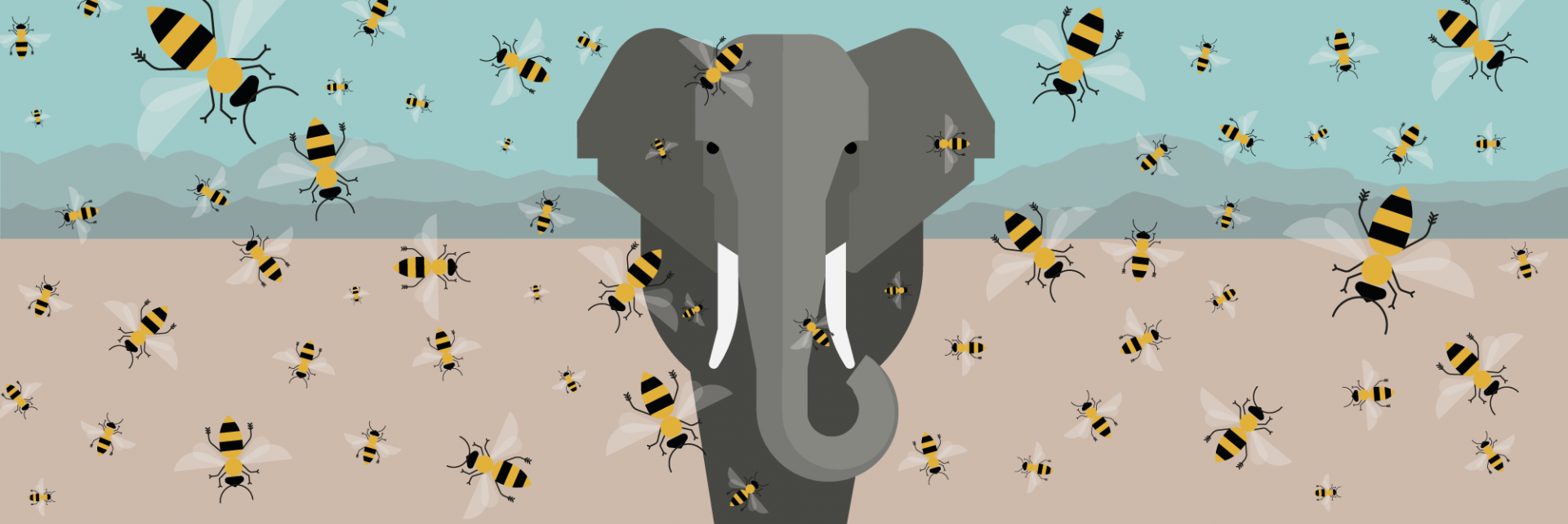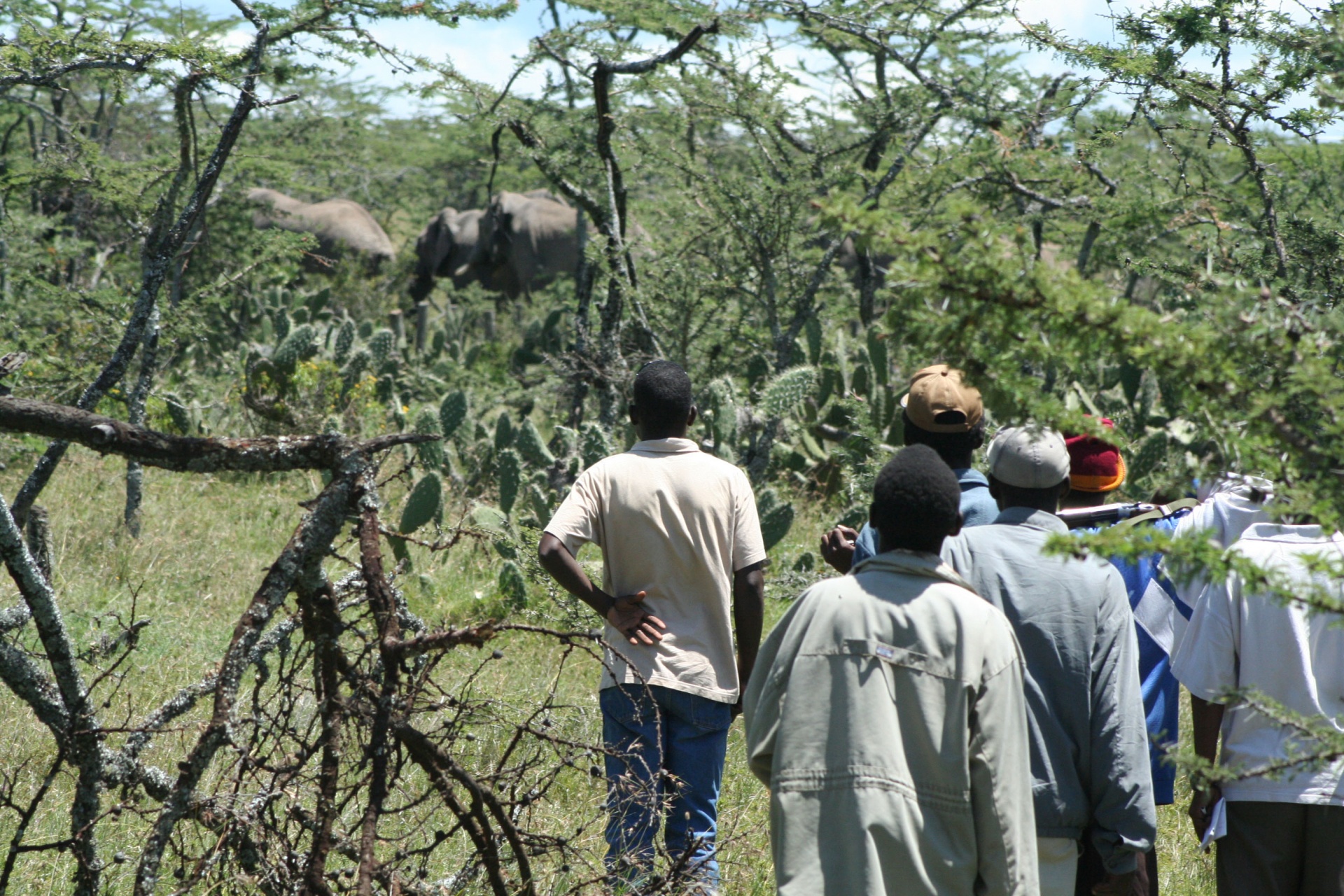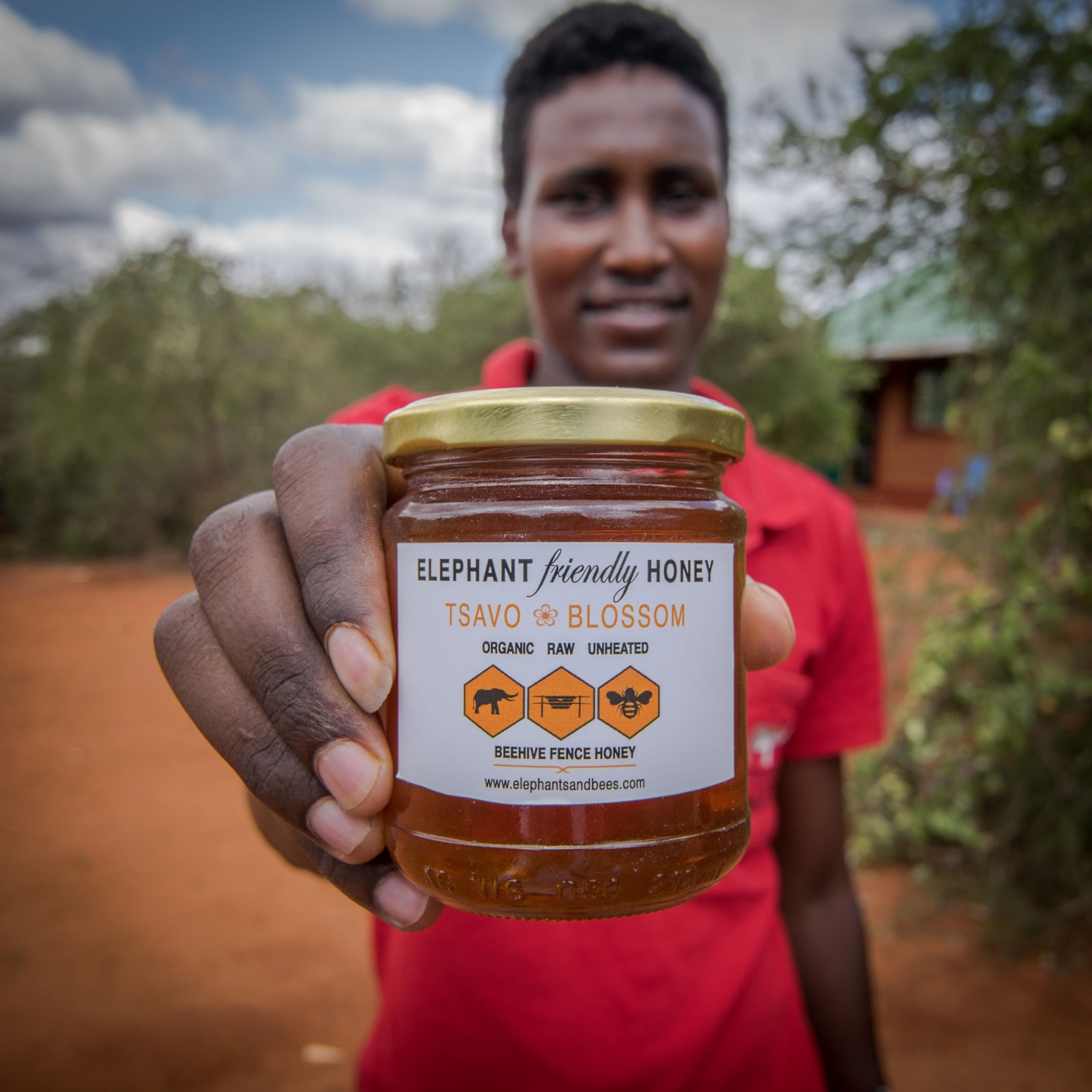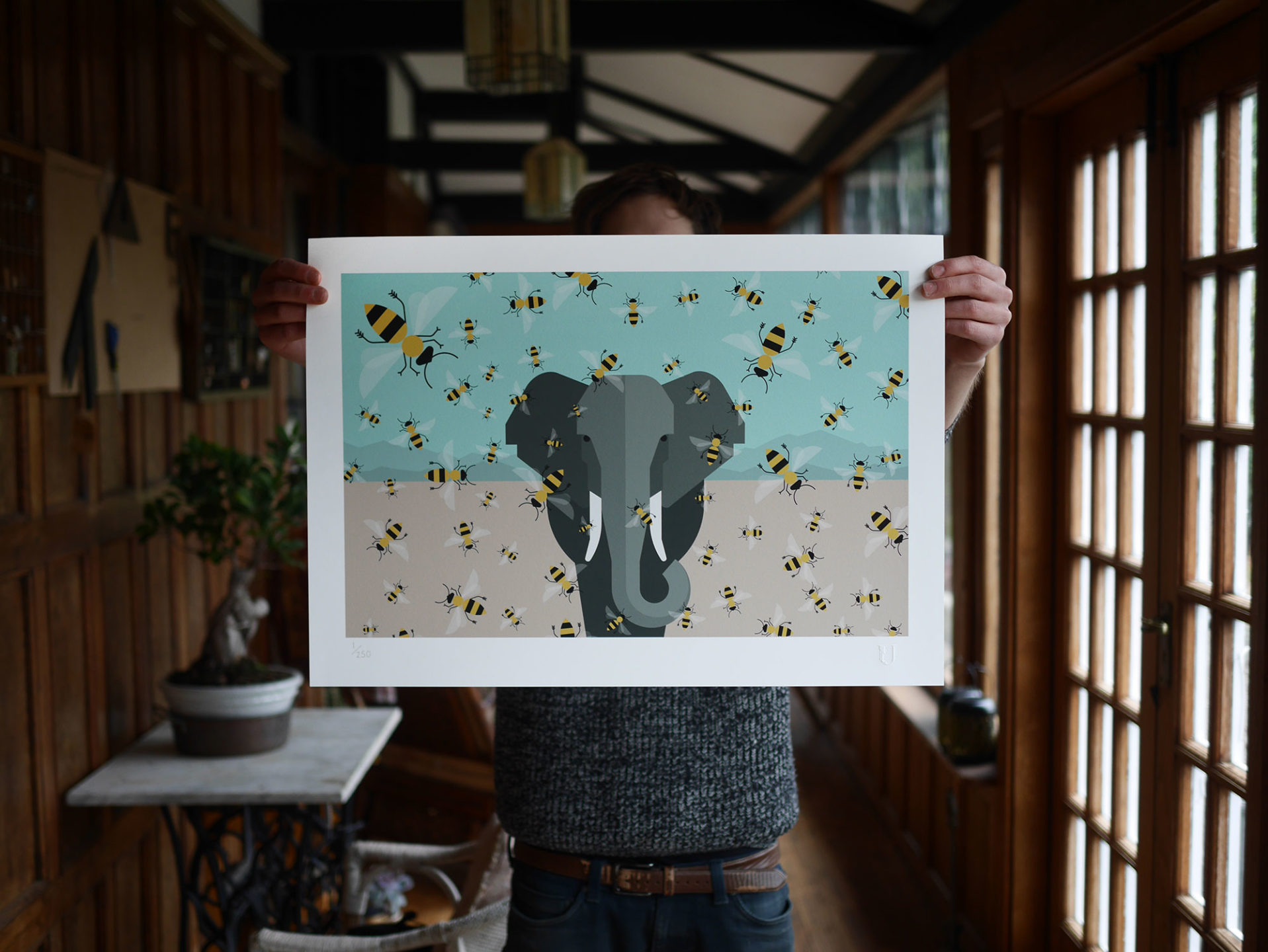

But these goliaths are afraid of tiny insects – bees. And where they are in danger from humans, this fear is being used to save their lives.
Catastrophic poaching of elephants in Africa during the 1970s and 80s saw their numbers plummet. Thankfully, CITES (the Convention on International Trade in Endangered Species of Wild Fauna and Flora) implemented an international ivory trade ban in 1989 which, combined with effective wildlife management, allowed them to recover. Although poaching continues and elephants are by no means safe from the threat of extinction, their populations have increased, particularly in east and southern Africa.
Yet in tandem with their increase has come the growth of human populations, and therein lies the conflict. Where elephants used to roam, there are fields. When they set off on their former migratory routes, they are confronted by development or farmland. And in farmland they break in to eat vegetables or trample over crops as they are passing through. The result of this is sometimes death – to either the elephant or the human. An elephant wounded by a farmer protecting his or her crops is dangerous, the family unit can become stressed and with such long memories, may be more aggressive towards humans in the future. The elephant may even be killed in retaliation, despite the fact that this is illegal.

Conservation can step in to help resolve this conflict, and in this instance, the resolution is one of the most ingenious and admired projects in the field. Elephants abhor bees, and well they should. With their 2.5cm thick skin, you would think they were safe from their stings, but they do have sensitive areas – around their mouth and eyes, behind their ears and inside their trunk. And young calves have thinner skin, so swarms (and African honeybees are notoriously aggressive swarmers) can do real damage. In fact, they have been known to kill African buffalo. Elephants are so terrified of bees they will flap their ears, stir up dust, make a noise and turn and flee.
This fear has been harnessed into a project of beautiful simplicity. The Elephants and Bees Project involves the use of beehive fences, erected around farms to keep the elephants out and protect the crops. Hives of bees are strung up between posts every 10 metres, linked by rope or wires. When the fence is disturbed by an elephant, the hives sway and the bees become aggravated, causing them to flee the hive. In turn, the elephants flee from the swarm and the farm.
In a trial of the method, the fences were a successful deterrent 80% of the time, and bring with them myriad benefits. Farmers have protection of their crops so they don’t have to defend them themselves and wound or kill elephants, and are less likely to kill elephants in retaliation for destroying their crops. The bees produce delicious “elephant-friendly” honey, which can be harvested and sold for extra profits in often poverty-stricken communities, especially since beekeeping is an age old activity in Africa. The bees provide pollination services for their crops, too which increases their yield, and a stable income can be a powerful alternative to wildlife poaching. It is a true win-win conservation project, for humans and for elephants.

The project is the brainchild of Dr Lucy King, the undisputed Queen of the elephants and bees initiative. Winner of the Unep/CMS Thesis prize at the 2011 Convention on Migratory Species (given for a particularly outstanding PhD thesis in the conservation field), Lucy founded the project and works alongside the charity Save The Elephants. That elephants have a fear of bees was first reported by Lucy, in a study published in 2007. It had previously been suspected – in Kenya there were reports that elephants damaged acacia trees with empty or occupied beehives significantly less than trees without any hives, and in Zimbabwe, elephants were observed to forge new trails in order to avoid beehives – but Lucy’s study confirmed it. The team of scientists digitally recorded the buzz of agitated African honeybees by setting up a microphone and recorder, dropping a stone into a beehive to trigger an attack…then running like hell!

The four-minute clips of buzzing were played via wireless speakers hidden inside fake tree trunks to elephant families resting under trees in Kenya during the midday heat. Of the 17 families tested, 16 responded by fleeing within 80 seconds of hearing the bee sounds and half of them fled within just 10 seconds. The one family that did not respond was young and had likely never experienced bee attacks before. A key aspect of this study was that the entire family moved away. If just one or two individuals did, beehive fences would not be an adequate deterrent.

A further discovery by Lucy King and colleagues added to the growing evidence of elephants’ fear of bees. In 2010, they found that elephants utter a distinctive rumble in response to the sound of bees. During the 2007 study, they had noticed that, when the elephants ran away, they shake their head and make a call that Lucy named the “bee rumble”. When, in 2010, a recording of this call was made to 10 elephant families, six of them moved away, even though they had not heard nor seen bees. When a different recording was played, which lacked the key acoustical features of the bee rumbles, only two families moved away. It seems elephants can alter their calls by changing the position of their tongues and lips, just like we do, so may even have calls specifically for humans and lions (their two other enemies) as well.
You may think from these studies that just playing a recording of a beehive or a bee rumble would be enough of a deterrent, but you would be forgetting how smart elephants are. If they don’t have the “negative conditioning” of a few stings, they quickly learn that the threat isn’t real.
For the work she had done with the beehive fences, Lucy won the 2013 St Andrews prize for the Environment (awarded by St Andrews University). This gave her financial support to expand her work to Asia. Humans and elephants have a long history of working and living alongside each other on this continent – elephants are sacred in the Hindu and Buddhist religions. However, the elephant population has experienced a rapid decline, as has their original habitat, but there has also been a rapid rise in the human population. Asia’s remaining 30,000 elephants are attempting to share shrinking space with approximately 20% of the world’s human population. They are increasingly living in small areas; islands surrounded by seas of human settlement.
Incidents of elephants raiding crops and villages are on the rise, and retaliation killing by local people is thought to be the leading cause of elephant deaths in Asia. In Sri Lanka, over 250 elephants have been killed, however, it was here that it was discovered that Asian elephants are equally scared of bees. Now, Elephants and Bees Projects are in operation in Sri Lanka, India, Nepal and Thailand, as well as 11 countries in Africa.

The latest research may lead to developments of the project. In 2018 it was found that elephants react to a pheromone produced by the bees when they are alerted to danger – when socks treated with it were hung around a watering hole in South Africa’s Kruger National Park, elephants left the area once they caught a whiff. This means that the pheromone could be synthesised and used as a repellent, an ideal solution for those farmers who perhaps can’t afford to maintain beehive fences.
A number of elephants in the project areas are collared, so that the scientists can collect data on their movements. The conservation world is increasingly using this type of technology, but the beauty of the Elephants and Bees Project is that it blends this high tech, with low tech – with such a simple design and no moving parts at all, the fences are a grassroots solution for people with no electricity.
Combined with a mobile unit to reach more conflict areas, an education programme they run to train young people and a women’s enterprise programme, it not only continues to expand its great work, it continues to save lives.

We’ve launched a limited edition fine art print titled ‘Elephants & Bees’ with 20% of proceeds going to Save the Elephants. Click the button below to find out more.

Read more articles from our contributing authors and follow the project progress by signing up to the Under the Skin newsletter.